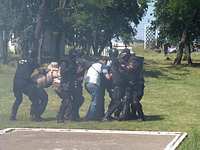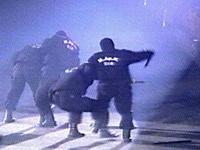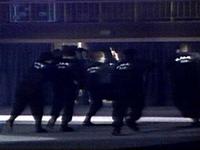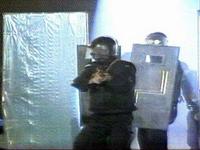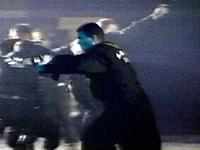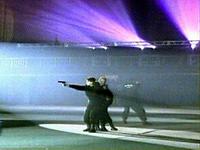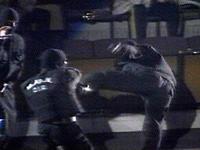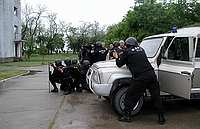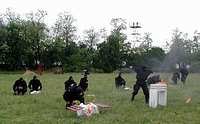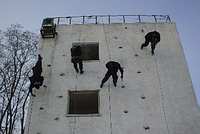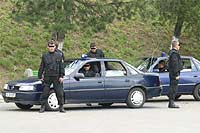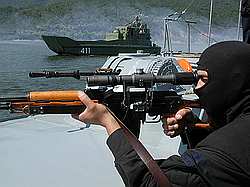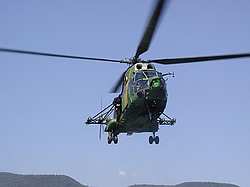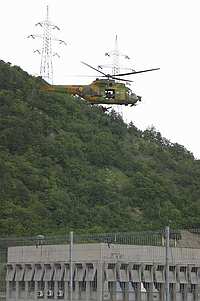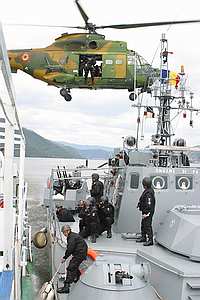| Detasamentul pentru Interventie Rapida - Rapid Intervention Detachment - |
|||||||||||
|
The Rapid Intervention Detachment of the Romanian Armed Forces passed through several changes in the past decade, consisting mainly of the name of the unit and the chain of command. |
|
||||||||||
The history of this amazing detachment
The Rapid Intervention Detachment has a long and complicated history. The last attempt to completely hide the unit from public opinion was abandoned when in december 2003 the Ministry of Defence confirmed the existance of DIR, the latest designation of this elite detachment.
Incorporating highly trained members, this unit is formed for the purpose of sending Romanian combatants to covert operations abroad, at the request of NATO and the United Nations. As it turns out, DIR members have been involved in a large number of operations in conflict areas abroad.
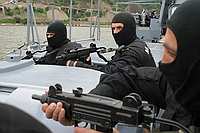 The first phase of the unit can not fully be track, but it is assumed it was created, under one form or another, in the early 1990s. The earlier public mention of the unit cites the early 1990s, when a small, elite detachment was said to exist in the military. The detachment, simply called "the special missions subunit", existed within the 30th Guard Brigade "Mihai Viteazul". The 30th Guard Brigade was composed of 3 guard battalions and 1 special detachment - this one.
The first phase of the unit can not fully be track, but it is assumed it was created, under one form or another, in the early 1990s. The earlier public mention of the unit cites the early 1990s, when a small, elite detachment was said to exist in the military. The detachment, simply called "the special missions subunit", existed within the 30th Guard Brigade "Mihai Viteazul". The 30th Guard Brigade was composed of 3 guard battalions and 1 special detachment - this one.
The three battalions were performing guard duties during ceremonies, international visits, as well as around the clock duty in the presidential palace.
The special operations detachment was probably performing close protection duties for foreign dignitaries while visiting Romania, as well as for Romanian military officials. Other missions are likely to have been performed as well.
In 2001, major cutbacks in the armed forces have meant the disbandment of the 30th Guard Brigade and its transformation into a regiment. The 30th Guard Regiment keeps the official name "Mihai Viteazul", however it is now composed of only two guard battalions.
The "special operations subunit" was then designated as DPDM - Detasamentul de Protectie al Demnitarilor Militari, or the Military VIPs Protection Detachment. Do not let the name confuse you, this is anything but a group of mere bodyguards. DPDM was not mentioned in any official documents, and its activity remained shrowded in mistery.
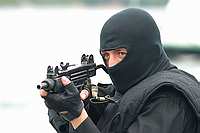 It is unclear in what order the detachment changed its command chain, but we can simply note the following changes: after being extracted from the 30th Guard Brigade, the detachment was for a while under the command of the Military Police. Then, by an order signed in april 2001 by Victor Babiuc, at that time the Defence Ministry of Romania, it was transferred under the command of the Directive of Military Protection and Security, the counter-intelligence section of Military Intelligence. It seems that after a while the detachment was transferred back to the Military Police, where it belonged in 2003.
It is unclear in what order the detachment changed its command chain, but we can simply note the following changes: after being extracted from the 30th Guard Brigade, the detachment was for a while under the command of the Military Police. Then, by an order signed in april 2001 by Victor Babiuc, at that time the Defence Ministry of Romania, it was transferred under the command of the Directive of Military Protection and Security, the counter-intelligence section of Military Intelligence. It seems that after a while the detachment was transferred back to the Military Police, where it belonged in 2003.
After that, it is possible the detachment was under the direct control of the General Chief of Staff, but that remains unconfirmed.
Big changes followed during 2004. After more than 80 years of having armed forces composed of three branches - ground forces, air force and navy, the Special Operations Command was created in october 2004 as the 4th major branch of the military. The Special Operations Command includes the Special Forces battalion, DIR, and PSY OPS.
As such, DIR belongs now to the Special Operations Command, where it is likely to remain for an indefinite period.
|
| |
|
What defines DIR ?
DPDM combatants are selected at a high failure rate and practice protection and CQB techniques on a daily basis. This closely-knit commando unit's single purpose is to accompany and secure military personalities in their daily activities, at work or whenever else necessary. |
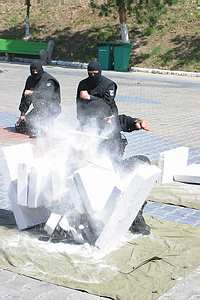
2000x3000, 519 kb JPEG
|
But perhaps the best men that the Defense Ministry and the Romanian Armed Forces in general lost, are the former DPDM fighters who quit, and left abroad to become personal bodyguards of characters such as Silvester Stalone and Madonna. | |
What does it take to become a member of DIR
A variety of weapons is employed by DIR operatives, which include but is not limited to the Jericho pistol, Uzzi submachineguns, AK-74S automatic rifles and Glock 17 9mm pistols.
DIR members have also been spotted using the PSL sniper gun, the PSG-1 and Steyr sniper rifles as well.
Apparently the entire detachment is stationed somewhere at the outskirts of Bucharest. Judging by the fact that all the photos during public demonstrations across the years have been taken in the Domnesti live firing range, we could safely assume that is one of their headquarters, if not the only one.
|
| ||
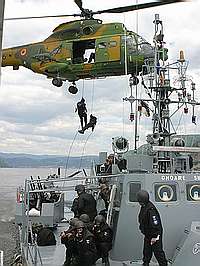 Blue Road 2004 |
It has to be mentioned here that DIR has a large number of international and national exercises every year. They take place with similar structures from other countries or within Romania, and there's so many of them that a reasonable track can not be kept or published here. |
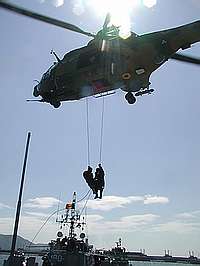 Blue Road 2004 |
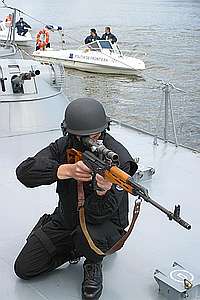 Blue Road 2004 |
Exercises sessions with international partners are difficult to track for the obvious reason that they are seldom publicized in the media. |
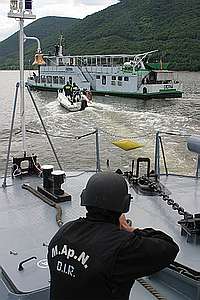 Blue Road 2004 |
The real life operations of units like this ones are most often classified and little information becomes available to the public. Such is the case of DIR as well, which oficially is not mentioned of being deployed abroad at any time.
However, in the world of special operations, reality and press articles do not meet very often. We also have to consider the very reasons for the creation of DIR in its current state and designation. Gathering the best men from the military in a single, small detachment, which lacks nothing in terms of equipment and funding, is surely something you don't do simply to perform demonstrations for foreign officials or to guard your own military VIP's.
I would keep this section short and remind of only one quote to complete it, until more information will become available. Asked by a reporter after the demonstration in december 2003 if he's ever been in a real operation, a young DIR member replied "aahh, many". Asked again, "how many exactly?" he continued: "there were a lot of them. I forgot their number".
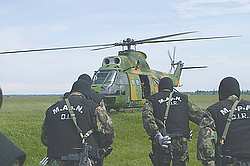
With the creation of the Special Forces battalion, one would expect DIR to be disbanded and all its operatives to be transferred to the new, integrated unit. But that wasn't the case - DIR remains as a stand-alone unit, one of the three units under the control of the Special Operations Command. Due to the fact that DIR had over 100 operatives in the mid 2000's, while the Special Forces battalion is designed to have 500, one could assume DIR would get to keep its status as an elite counter-terrorist unit of the military. If we add the fact that the Special Forces have at least one module built to be inter-operable with the US Army Special Forces (Green Berets), one could assume DIR could have adopted the SAS model of a small, counter-terrorist, special operations capable detachment.


